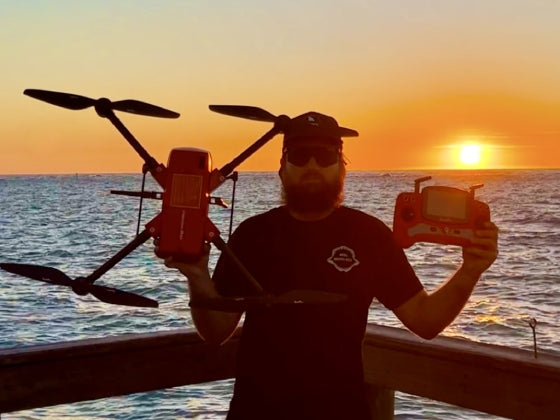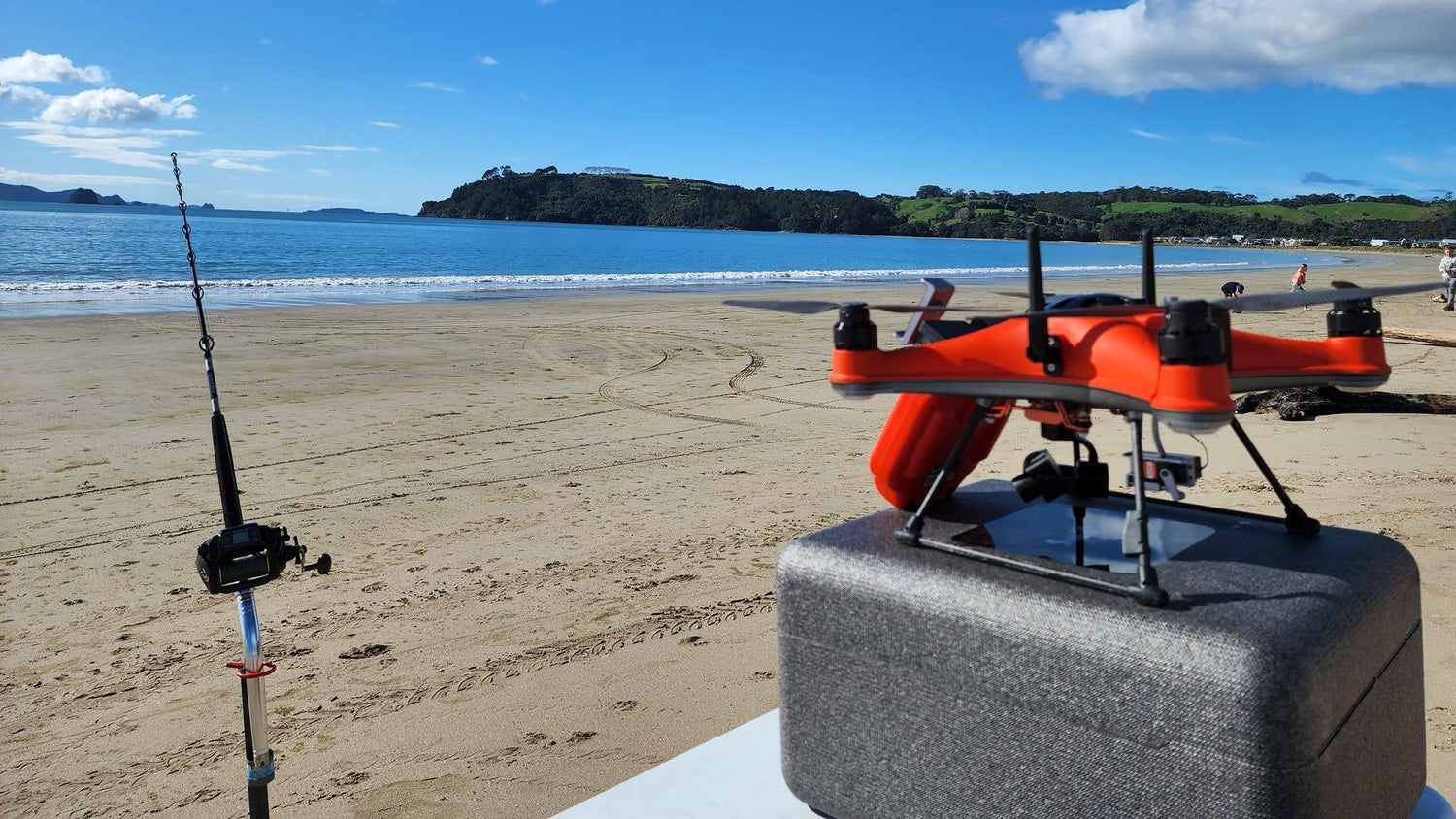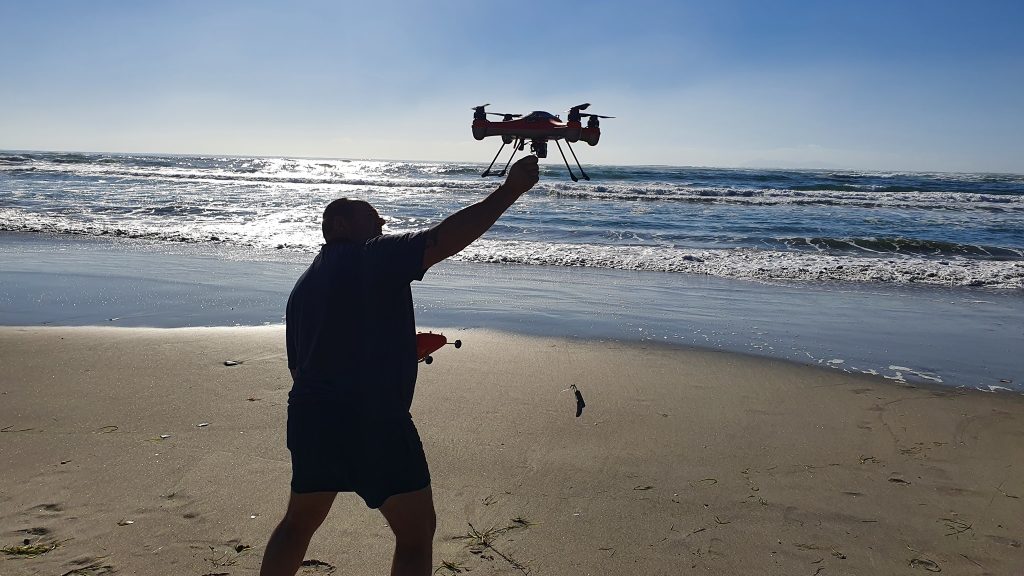If you like sitting around the sea and savoring your free time, drone fishing is something that can be appealing to you. While fishing works as a fantastic pastime, a drone can make it much more fun and ensure that you have a catch every time.
Whether you plan on doing it as a career or a hobby, drone fishing offers many benefits. So, how does it work? What do you need to do it? Is fishing with drones indeed the future? Here’s everything you need to know.

What Is Drone Fishing?
As its name suggests, it is angling with the use of a flying robot. Drone fishing offers several ways to simplify the process of fishing. Rather than gamble your time away with a chance at getting good fish, you can utilize unique drone features to optimize how to get the fish you want.
There are many ways to do drone fishing, depending on how much work you want to do yourself. For starters, you can use the fishing drone to scout for a fishing area. Rather than using the drone to pull the fish, you use it as an aid to scout for an excellent place to fish and find the best spots you can use.
Some drone fishers connect their underwater camera to check out the local fish population. You can use your drone camera to scope the local waters if you’re hunting for specific fish like tuna, salmon, or others.
Another way to do drone fishing is to use it as a bait release drone. As the drone flies around, it casts off the bait, giving you ample opportunity to catch fish. You can use various types of bait to get more fish, from throwing chum to get more fish in one area to using worm bait to reel in fish.
The most common use of drones in fishing is to reel in fish, known as “dropping the line.” Rather than use a fishing line, you can have a drone do the catching for you. Depending on how much interaction you want, this can be the least fun part of drone fishing. However, this is also the best way to get a catch every time.
Drones are fantastic for career fishing, especially if you like reeling fish from your boat. You can extend your catch range or add a few extra meters to your fishing zone.

How Does Drone Fishing Work?
If you’ve never done any boating or have been away from this hobby for a while, you may be wondering what goes into doing these activities. In this case, it’s best to start with the basics.
First, you need to know the laws surrounding the use of your drone. Most countries have regulations regarding where and when you can fly your craft. While some places allow you to use yours freely, others require you to get a license, register your aircraft, and adhere to other requirements.
Next, you need to learn how to pilot your drone. You must learn how to control your copter and maintain and fly it properly. You need to learn special piloting techniques if your drone is huge.
Third, you must ensure your drone is equipped for fishing and not just for show. There are several types of bait-dropping mechanisms, depending on your drone model.
For example, SplashDrone 4 and Fisherman FD1 are purpose-built drones with integrated bait droppers. They also have a remote-controlled line release and many more. Another type of drone includes a tension-triggered release line, which utilizes DJI-compatible bait droppers.
Finally, you need to find a good spot to launch your drone. There are plenty of great places for launching a drone, from public waterways to private property. Depending on your needs, you can also use your boat or fly from the shore as a staging platform.
Who started drone fishing?
Drone fishing was not always how it was today. Fishing with drones is still a new activity even after a few years. The activity started with a certain Milton Frear, the owner of JCMatthew in New Zealand. The company deals with different high-quality adventure brands and technology, from camera equipment to personal transportation.

Frear was the distributor of SwellPro in New Zealand, one of the first waterproof drones publicly available for purchase. He used the first-generation waterproof drone, the Mariner, for bait-dropping on the beach in 2014. This personal choice was a clever use of a feature not for its intended purpose.
How?
The Mariner had a release mechanism initially designed to drop live-saving equipment during an emergency. However, as a lifelong fisherman, Frear understood the novel way of utilizing the feature to drop some bait and get the fish going.
Later on, several people started using their drones for fishing too. In particular, Jaiden Maclean of Sea Ulcer wanted to prove if they could fish using drones. Their Youtube video, “Drone Fishing For Tuna,” was a testament to the viability of fishing with a good drone.
Their video went viral, garnering as many as 5.3 million views and influencing an audience that loves fishing and flying drones, combining them into one unique hobby. This inspired many would-be anglers to try drone fishing, and it took off from there.
Swellpro is the first company who made a waterproof purpose-built fishing drone with an integrated release mechanism. This allows easy fishing and combines scouting, baiting, and angling in a single drone loadout.
Is Drone Fishing Worth It?
Drone fishing is an enjoyable activity for many people, especially due to its many benefits. Whether you’re doing it as a hobby or as a career, using a drone to get some good fish is fun. While some may think it’s less challenging, it also has its own technical hurdles that you need to overcome.
So, is drone fishing worth it? Yes! Here are some benefits you can expect when you start drone fishing.

1. Extend The Range Of Your Cast
As the title implies, this allows you to extend the reach of your casting. While a conventional rod has a range of 10 to 15 meters, your aerial capabilities can extend that to as much as 100 meters. This allows you to cover a wide radius, making your chances of getting a snag or a fish much higher.
While you can always use a boat to find the fishing spots you want, you can also use a drone and stay on the shore. This gives you a way to go fishing in locations that need a boat to access it, offering a richer space to gather the fish you want.
2. You Have Better Control Over Your Lure
When using conventional rods, you have to rely on hardware to release your hook and lure. When the bait hits the water, your gear must do the rest. The issue with this approach is that you have no say in how the lure behaves once it enters the water. If you use a deep-sea fishing rod, then it can sink to the bottom, making it hard to retrieve them.
The mobility of an aerial vehicle gives you more control over your gear. You can quickly move to the best location to make your drop. You can also adjust how fast you move your gizmo, allowing you to bring it in fast or slow, depending on what you’re trying to achieve.
3. Scout For Good Fishing Spots
Using your UAV, you can simultaneously do two things: find a great place to angle and find the right spot for the right species. Scouting with a boat or a kayak can be limiting.
If you can’t access an area by boat, then all you can do is hope for the best. On the other hand, when you use your droning to fly over the ocean, you can find a great location for different types of fish and sea life. This lets you modify your technique to make sure you get what you want.

4. Saves Time And Money
While most hobbies cost money, this one can actually save you money, especially if you do it regularly. Unlike traditional boats, you don’t require gas, insurance, or anything else with drone fishing. All you really need is an appropriate form of electricity to power your drone and your other fishing gear..
While you may be thinking it’ll take a lot of time to get the hang of doing this kind of recreational sport, it actually saves you time and effort. As compared to traditional forms of sports, this one doesn’t take as much physical exertion. You also don’t need to lug heavy boats or drive your car to get some fresh fish.
Can You Use Any Drone For Fishing?
If you’re thinking about getting into drone fishing, then you might be wondering if you can use your old drone to do some cool tricks. While it can, the results will be less than stellar. You want them to have the right specs.
For starters, you want the drone to be 100% waterproof, from the copter itself to the camera and reeling equipment it uses. Drones can easily die with a strong splash of water with a big wave. You want the vital electronic parts protected so you can keep it operational.
You also want a fishing drone that can handle high wind resistance and high payload capacity. The oceans pack strong winds, so your drone should be able to handle somewhere between 29 to 50 kph winds. As for payload, depending on the fish you want to catch, you want to go up to 1 to 2 kgs, which is enough bait to catch you a tuna.
You also want a drone with a long flight time to allow for more drops per single charge. This also gives you more time to get your drone come back to safety if you’re fishing from the beach. You also want a good, high-quality camera, preferably an underwater camera for better scouting.
What Are The Best Drones For Fishing?
There are three excellent options on the market if you’re looking for fishing drones. Depending on your needs, every drone offers a different feature. These include:

SplashDrone 4
SwellPro’s SplashDrone 4 is a 5th-gen waterproof drone, offering features that fit every drone fisher’s needs at every skill level. It can float and has IP67 seawater proofing, with the ability to withstand Beaufort Force 7 winds (31 mph/50kph) during its flight.
It also offers a swathe of features that allow multifunctional payload and open interface design. This allows you to equip the SplashDrone 4 with optional 1- to 3-axis payloads, from 4K, night vision to thermal cameras. It has a 30-minute flight time without load, with around 12 to 15-mins flight time with payload.

Fisherman FD1
Fisherman FD1, on the other hand, offers almost the same specs, with an IP67 seawater proofing and a max payload capacity of 2kg. It also has a max wind resistance of 44.75 mph/ 72 kph but an equivalent flight time to the SplashDrone 4. Its massive casting range gives you a 1.6 km radius and up to 6 bait drop missions per charge.
 Spry+
Spry+
Spry+ offers a different value than the SpalshDrone 4 and FD1, working as a lighter scout drone with an 800 m control range. Its 4K30fps camera offers easy scouting opportunities for high quality video opportunities. Its waterproofing and corrosion resistance offers a way to scout the waters with no issue at all.
How Much Does A Fishing Drone Cost?
The normal price range for a quality, durable, and functional drone for fishing and outdoor/aerial photography is between $1000 to $2000. This depends on factors like the brand, type, and weight of the product.
The cost varies, depending on the features and capabilities you want your droning to have. Some models like the Spry+, for example, are much cheaper compared to other options. The Spry+ costs somewhere around $1000, while the SplashDrone 4 costs around $1800.
While this may sound expensive for fishing, you need to remember that a fishing drone can replace several fishing equipment. It can replace a set of fishing rods, scouting gear, boating fees, and underwater cameras.
What Is The Longest Flight Time For A Fishing Drone?
The 20 to 30-minute battery life of most standard consumer-grade fishing drones, which is more than enough for an average fishing trip. The SplashDrone 4 and the Fisherman FD1, for example, can fly for 30 minutes without any load.
It can traverse the 1-2km radius of your cast, offering you plenty of opportunity to get the bait in the water. Most recreational drone users spend around 15-20 minutes to do multiple bait drops. A few minutes is more than enough to fly the drone over great distances.
Conclusion
As you can see, there are plenty of reasons why you should consider drone fishing. From its versatility to the sheer amount of things you can do, drone fishing is the future. From helping you find the best place to dropping your lure, you can do so much with one amazing tool.If you’re looking for a great way to spend your time, then investing in a quality fishing drone is one of the best decisions you can make.



